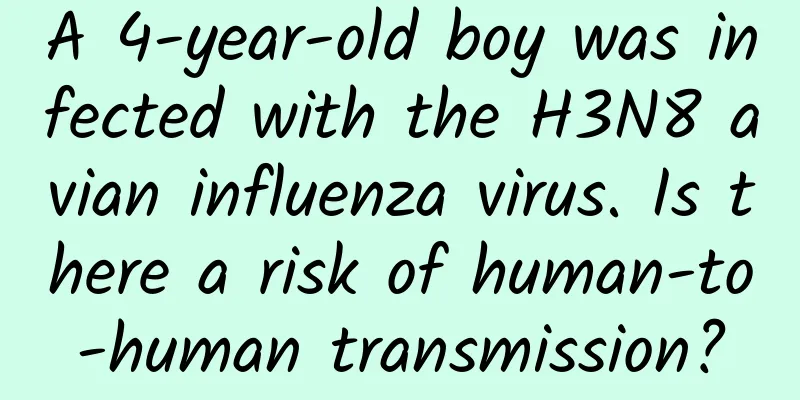A 4-year-old boy was infected with the H3N8 avian influenza virus. Is there a risk of human-to-human transmission?

|
◎ Science and Technology Daily reporter Zhang Jiaxing On April 26, the National Health Commission reported that a 4-year-old boy in Henan was infected with the H3N8 avian influenza virus. Subsequent medical observation and sampling tests on close contacts of the infected person showed no abnormalities. The National Health Commission pointed out in the notice: The H3N8 virus has been detected in horses, dogs, poultry and seals around the world in the past, but no human cases of H3N8 have been reported. Why can the H3N8 avian influenza virus, which is supposed to spread among poultry, cause illness in humans? How does this virus spread across species? Will it spread from person to person in the future? Why can H3N8 make people sick? The COVID-19 pandemic has made many people realize that if the protein "key" on the surface of the virus can open the protein "lock" on the surface of human cells, it can invade the cells and cause infection. The "key" to the new coronavirus is the S protein, while one of the "keys" to the influenza virus is the HA protein. These proteins are like the barbs on "tricholoma" that can hook onto cells and fuse themselves into them, but the human influenza virus and the avian influenza virus can "hook onto" different receptors. Gao Fu, an academician of the Chinese Academy of Sciences, explained in detail in his popular science book on influenza viruses: the main cell receptor for HA protein of avian influenza virus is α-2,3-galactosyl sialic acid receptor, while the main cell receptor for HA protein of human influenza is α-2,6-galactosyl sialic acid receptor. Human upper respiratory tract cells have the latter receptor, and the lower respiratory tract has the former receptor. Under normal circumstances, avian influenza virus does not easily penetrate into the lower respiratory tract of humans. Even if it does, it will be bound by tissue mucus and difficult to spread. However, it is not ruled out that some avian influenza viruses have the ability to bind to α-2,6-galactosidyl sialic acid receptors, and H3N8 is one of them. In the academic paper "Study on Biological Characteristics of H3N8 Subtype Avian Influenza Virus in China from 2009 to 2013", the receptor binding specificity of 29 strains of H3N8 avian influenza virus that appeared in my country was analyzed, and it was found that they have the ability to bind to both receptors. The researchers believe that the H3N8 avian influenza virus currently prevalent in my country has the potential risk of infecting humans and spreading among the population. It can be seen that some H3N8 avian influenza viruses themselves have the ability to infect humans, but the actual infection and disease occurrence is also related to other factors such as the size of the infectious virus load and the physical condition of the infected person. How do influenza viruses spread across species? "Influenza viruses generally need to accumulate core mutations to achieve cross-species transmission." A researcher who has been continuously tracking the evolution of avian influenza viruses told Science and Technology Daily that the virus accumulates mutations simultaneously during the process of transmission and evolution, which may lead to cross-species transmission. Taking the H7N9 virus that spread in my country in 2013 as an example, relevant research institutions found that it was formed by the reassortment of avian influenza viruses from chickens and ducks. Gao Fu explained in detail in the book: The tracing study of the H7N9 virus found that the virus may have reassorted directly from the chicken body, acquired the ability to infect humans and directly evolved into a new influenza virus. In addition, due to the diversity of influenza virus host types, pigs, dogs, etc. are considered to be "mixers" of its reassortment. A report titled "Progress in Research on H3N2 and H3N8 Subtype Canine Influenza Viruses" shows that most tissue cells in dogs have sialic acid receptors for human and avian influenza viruses. Influenza viruses that infect dogs have undergone multiple amino acid-specific mutations in the HA site, which is speculated to be the cause of cross-species transmission. Will it spread among the population later? The National Health Commission’s announcement showed that experts had been organized to conduct a risk assessment and believed that the epidemic was an accidental cross-species transmission from birds to humans, and the risk of a large-scale epidemic was low. Will cross-species transmission lead to human-to-human transmission? The aforementioned researchers said that the former is a necessary condition for the latter, but not a sufficient condition. That is to say, human-to-human transmission is possible only after cross-species transmission occurs, but it does not necessarily lead to human-to-human transmission. According to literature reports, only a few types of avian influenza viruses have spread across species to humans and have caused very limited individual family clusters. In general, the possibility and probability of human-to-human transmission of H3N8 is still unknown, and we should remain vigilant. The public should still try to avoid direct contact with live poultry products in daily life, let alone contact with dead poultry. At the same time, high-tech means such as big data and model analysis have been used to track and warn about avian influenza viruses. A study by Chinese scholars previously published in the Proceedings of the National Academy of Sciences of the United States showed that by analyzing the mutation of avian influenza, the spread and evolution history of the virus between provinces can be inferred, and then the spread pattern of the virus across the country can be summarized, and the relationship between it and the live poultry trade and wild bird migration can be found, which may effectively predict the risk of avian influenza transmission. Source: Science and Technology Daily Editor: Zhang Shuang Review: Yue Liang Final judge: He Yi |
<<: What health issues should you pay attention to when riding shared bicycles?
>>: A 1cm live worm was removed from the boy’s eye. Pet parasites must be prevented!
Recommend
2022 Kunming Tea Drinking High-end Audition Top SN Venue, Drivers Who Have Experienced It Say It's Good
2021 Kunming tea drinking high-end auditions top ...
Why can’t a girl unscrew the cap of a bottle but can unscrew the top of her boyfriend’s head?
【appendix】 1. When a factory produces bottled bev...
How does Baidu bidding creative match keywords?
I am building 3 promotion groups (promotion units...
Anxin No Source 3.0, a collection of three explosive gameplays, worth 8888 yuan
Course Description: The course comes from Anxin’s...
Kuaishou live broadcast popularity reaches 10w, which will instantly increase your fans!
Professional Douyin and Kuaishou likes-boosting p...
New Media Operation Writing Guide!
What should a novice do if his writing is rejecte...
Jesse's Trading System (half-year course) with instructions + video course
Course Catalog Chapter 1 Lesson 1 2021 Daily Limi...
Comparing Apple Watch and Google Glass: Can the latter teach the former something?
It's hard not to hear about the Apple Watch t...
There is no duck in the duck blood for hot pot? 15 types of duck blood were tested, and the results were unexpected!
After testing the authenticity of mutton skewers ...
Worried about getting lost in space? A new method can help you find your way home, and it's really good
New interstellar navigation system Artist's i...
Four Seasons Health Diet Therapy Course
Four Seasons Health Diet Therapy Course Resource ...
How much does it cost to customize the Wuhan photography mini program? What is the price quote for customizing the Wuhan photography app?
There is no doubt that the topic of mini programs...
How to avoid invalid clicks in bidding advertising and SEM delivery?
In Internet advertising, paid-per-click advertisi...
How to acquire customers with short video ads at low cost?
In the past two years, many people have seized th...
Insights | Hello, 2022!
Everything is possible and all expectations will ...









